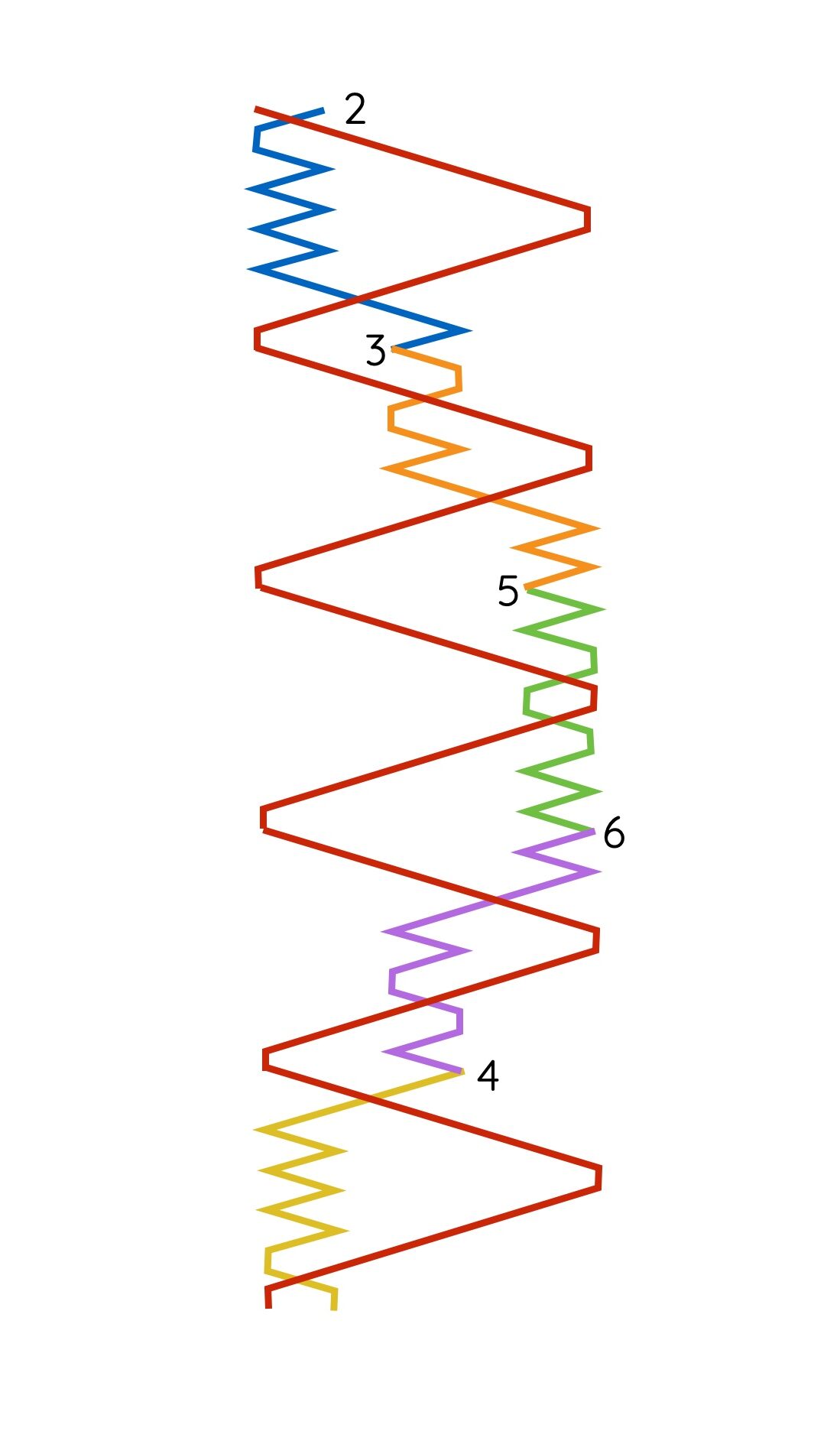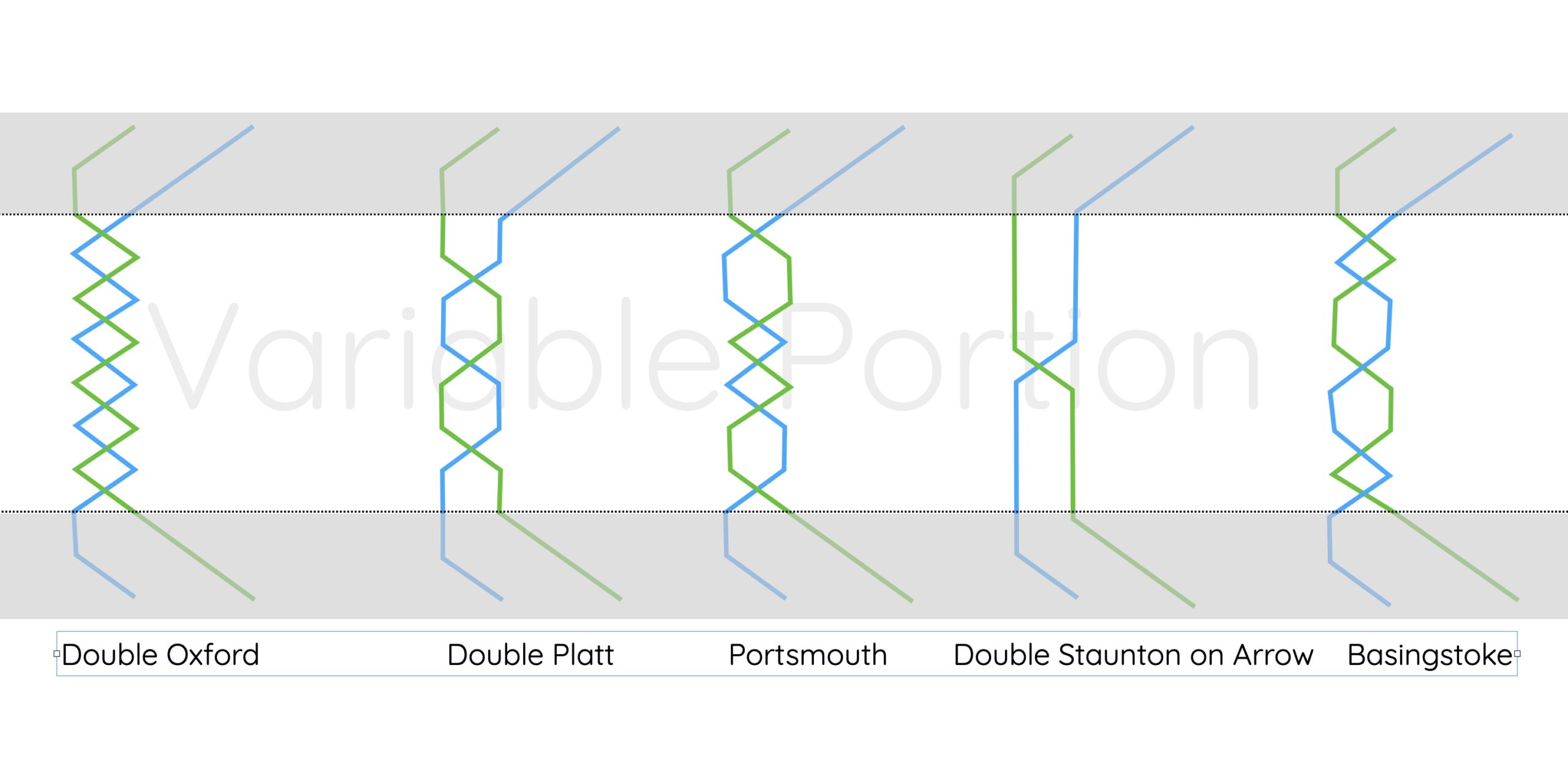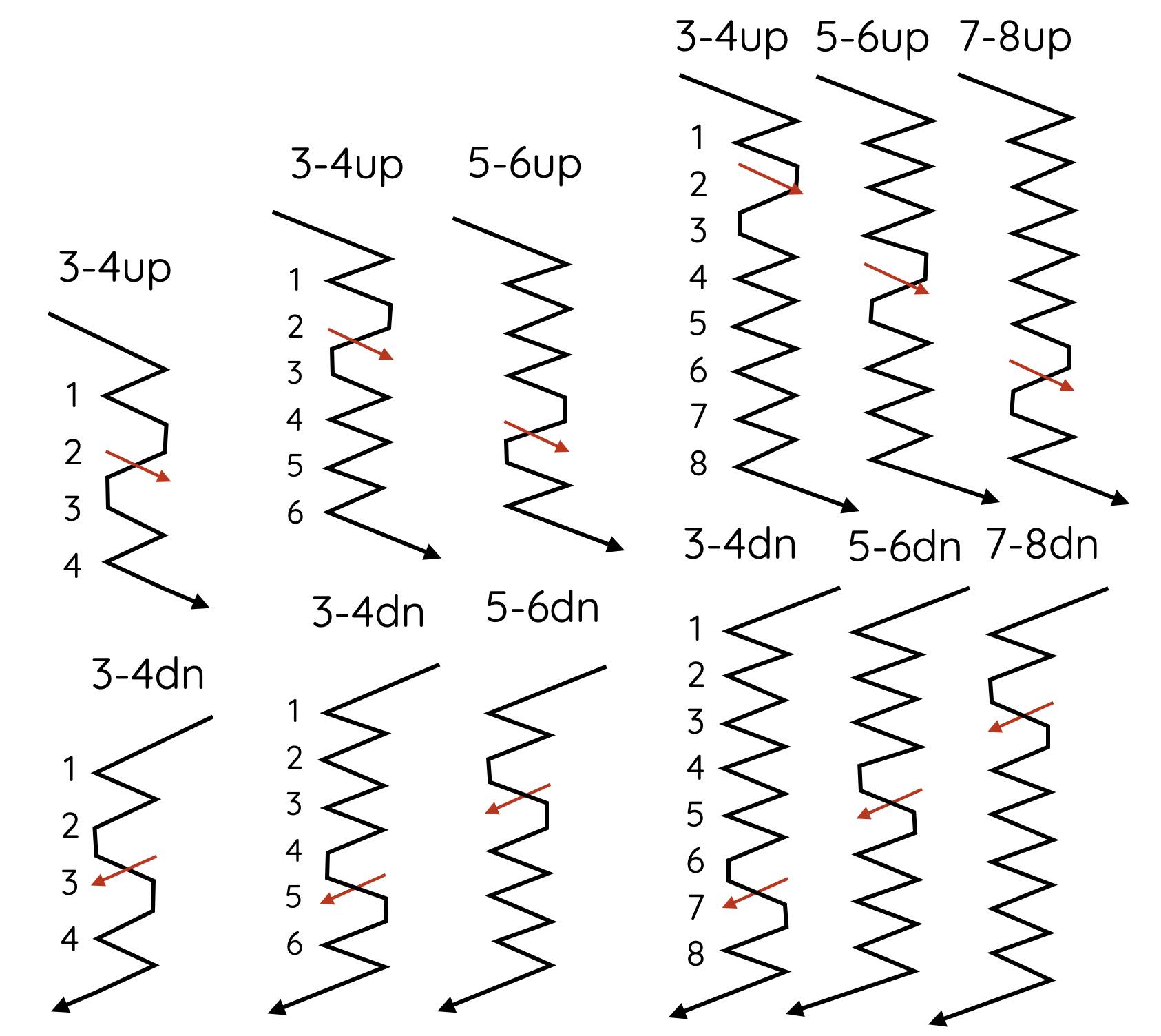
A Double Method...
Double Oxford is a’ Double’ method… as the name suggests!This means it has double symmetry
It is symmetrical top to bottom (palindromic) – just like most methods we ring.
It is also symmetrical front to back – so the back work mirrors the front work. (A double palindrome)

Symmetry
Because it is double, the method breaks into 4 similar parts… which makes it visually easy to remember… however, because there are 5 place bells and 4 quarters…. nothing quite matches up, so we still need to follow a full learning process!

The Line
The method splits up into front middle and back work portions:
The front work consists of 3 dodges.
The back work is also 3 dodges.
The middle work is the same length, but dodge, place, dodge, in order to allow the treble to hunt from front to back.
The rules for passing the treble are slightly different to Plain Bob, to take account of the more static line…
Pass Treble 1-2, make seconds (mid front work).
Pass Treble in 2-3, between front and middle work.
Make a places in 3-4, to allow the treble to pass.
Pass Treble in 4-5, between middle and back work.
Pass Treble in 5-6, make 5ths under the treble (mid backwork).

Place Bells and Starts
The place bell order is 2 3 5 6 4… the same as St Clements and the reverse of Plain Bob.
Place bells remain an important element of learning the line… without knowing them, you will not know the starts and will come horribly unstuck at a bob, single or splice.
Place bells:
2nds. Second half of the front work… finishing 3-4up at the beginning of the middle work.
3rds. Middle work (continued)… starting with places (4ths- 3rds)) around the treble… then dodging with the next middle work bell and moving to the back work.
5ths. dodge until the treble arrives. Make 5ths under and start the second block of dodges.
6th. dodge until the treble arrives… pass in 4-5 and enter the middle work.
4th. Start the front work triple dodges…. finish by making seconds and seconds place bell!

The Treble
The treble hunts, but the order between up and down is different.
The first two bells passed, will be the front work bells… these will be working at the front for the whole lead, so will also be the last two bells passed on the way back.
Next pass the middle work bell and the bell leaving the backwork…
The last bell will be staying at the back, so will also be the first on the way back… N.B. this means you ring two consecutive blows over it!
The middle work bell is now moving to the back and the bell which left is in the middle, so these two have swapped place.
Like many methods, the last bell makes seconds at the lead end, so will be the first in the next lead.
In summary… A-B-C-D–E going up becomes E–C-D-A-B going down… so not quite a mirror image!

Middle Work
For many… Double Oxford will be the first method learned which has middle work.
Two sets are made in each lead… the first is an up bell… the second a down bells.
It is the equivalent of 4 dodges, but actually consists of dodge place dodge… with the treble passing through the places… (which is a really helpful pointer to those who don’t like places!)
The first dodge is with the bell completing the places and last dodge is with the bell taking over the places.
This pattern is also a common feature of surprise methods… so ringing it, is a useful skill to master…

Bobs and Singles
Bobs are 14 (4th place), so the same as Plain Bob.
- At the and of the middle work, miss the dodge… Run in …2nds place bell.
- If Leading, Run Out …3rds place bell and the middle work places!
- Finishing front work… Make 4ths (the bob). 4ths place bell… restart the front work.
- All other bells are unaffected, no matter how many bells you add….
At a Single…
- Making seconds is unaffected.
- Middle-work bell will make thirds and do more middle-work. (effectively 5 consecutive places 4-3-4-3-4).
- Finishing front work… Make 4ths (the bob). 4ths place bell… restart front work.
- All other bells are unaffected, no matter how many bells you add….

Other related methods...
As well as ringing 3 dodges front and back, it is possible to ring a number of alternatives…. here are 4 more, but there are many others!
If these are applied front and back the method will remain double and may have ‘double’ included in the name, but they can be applied differently too, so many, many possibilities arise!

Touches
- A Bob course of St Clements is 60 changes.
- Alternate leads will produce 48 changes.
- A Bob every third lead will render 180 change.
- 2 Bobs every 3 leads will also render 180 changes.
- Calling Bob, single, plain twice will provide 95 changes and is false… but lots of fun for a practice night.

False But Fun...
Finding different alternatives to the most basic touches can be a problem for practice night… so why not ring something you would not be allowed to do in a performance…. A false touch…!
Any St Clements touch will also work for Double Oxford as they have the same course bell order.
- Bob wrong, make the single single home will produce 143 changes.
- Then there are combinations of Bob, Single twice…
Bob, single, 3 misses, Bob, single… will render 95 changes.
Bob, single, 2 misses, Bob, single, 3 misses, will render 131 changes.
- Bob, single miss, Bob Single will render 83.

Extending to Major
Extending is very simple… add an extra dodge for each extra bell.
So for major – front and back work therefore become 5 dodges.
A second set of middle work also needs to be added in 5-6.
- Each set of middle work needs to be the equivalent of 6 dodges (actually 5 + a place) to match the front and back work.
It still contains one set of places… enough to allow the treble through, so it is either
- dodge, places, triple,
- triple , places, dodge.

Extending to Royal
Extending is very simple… add an extra dodge for each extra bell.
The front and back work therefore become 7 dodges for Royal.
Extra middle works also needs to be added in 5-6 and 7-8. Each set of middle work needs to be the equivalent of 8 dodges (actually 7 + a place) to match the front and back works. They still contains only one set of places… just to allow the treble through…
This might be:
- single, places, sextuple.
- triple, places, triple.
- Sextuple, places, single.

Extending Middle Works
In minor there is one set of middle work, so all is simple and it is internally symmetrical as well as being symmetrical within the whole line… just like everything else.
In major however, we need two sets of middle work… one in 3-4 and the other 5-6.
The result is that the two works need to be mirror images with each other, in order to maintain the symmetry or the whole method, but the treble cannot pass through both at the same time… this is why we end up with a single or triple dodge either side of the places.
In Royal, there are three sets of middle work… so all three have to maintain symmetry as a set… which means that the middle set can once again have internal symmetry.
Below are links to Blue Line and the CCBR Library…
- The Blue Line page, shows the double hunt version which requires an odd number of bells. The is also a caters version, but like most double hunt methods (with the exception of Grandsire) neither are commonly rung.
- The CCCBR Library page is well worth investigating, because it lists all the related methods, variations and other linked methods…. There are an awful lot too!
